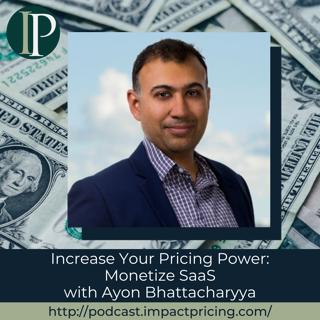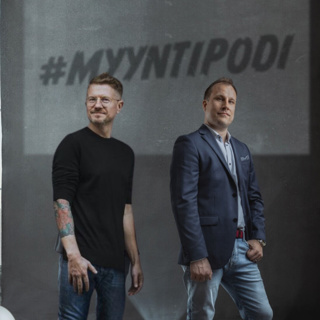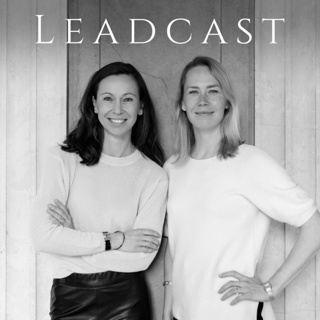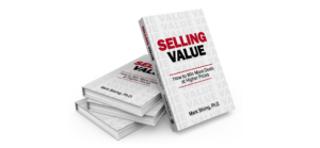
Blogcast #53: Selling Value
This is an Impact Pricing Blog published on April 20, 2022, turned into an audio podcast so you can listen on the go. Read Full Article Here: https://impactpricing.com/blog/selling-value/ If you have any feedback, definitely send it. You can reach us at mark@impactpricing.com. Now, go make an impact. Connect with Mark Stiving: Email: mark@impactpricing.com LinkedIn: https://www.linkedin.com/in/stiving/
6 Touko 20222min
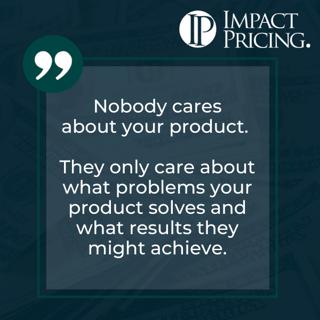
Memecast #56: Nobody Cares About Your Product
It's absolutely true, people don't buy products, they buy solutions to problems. When we talk about our products, when we talk about our features, that doesn't truly resonate in the minds of our buyers. Instead, what we need to be doing is talking about the problems that we're going to solve as well as the results a buyer might achieve. When we can capture their attention, recognizing the fact that they have a problem and getting them to agree that they have that problem, and then describing the results they might be able to achieve by solving that problem, now we're getting their attention. These are things they can truly value. And by the way, maybe we're solving more problems than they originally thought they were when they were looking for a product like ours. When we truly understand problems and results for our marketplace, and we can talk to our customers that way, our customers then perceive a lot more value, which means we can win these deals at higher prices. And that's really the whole point. We hope you enjoyed this memecast. This impactful insight came from the book, Selling Value, which I wrote to help salespeople win more deals at higher prices. If you have any questions or feedback, please email me mark@impactpricing.com. Now go make an impact. Connect with Mark Stiving: Email: mark@impactpricing.com LinkedIn: https://www.linkedin.com/in/stiving/
4 Touko 20221min
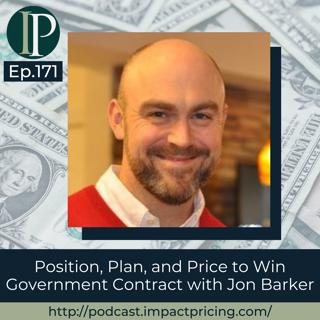
Position, Plan, and Price to Win Government Contract with Jon Barker
Jon Barker has been involved in managing government contracts from the supplier side his entire career. He started a company called PTW Solutions, where PTW means Price To Win, and they help companies win government contracts. Jon is an avid coach and he's coached both lacrosse and soccer. When coaching, Jon fosters a team environment, while learning the strengths and weaknesses of each individual to build up skills and confidence. In this episode, Jon talks about government contracting as he puts emphasis on why the government’s focus is set on cost-plus. Why you have to check out today’s podcast: Learn how pricing runs in government contracting Discover what a “probability of win” means and why you should focus on deals with higher “probability of win” Find out resources you can visit as you look for data of your competitors’ prices “Create your own internal models of the data that you use a lot to make those decisions, and have the ability to make the levers change easily. I think as a government contracting pricer, it would be extremely beneficial.” – Jon Barker Topics Covered: 01:36 – The start of Jon’s pricing journey for government contractors 04:39 – Small businesses having more volatility with government contracting if compared to large companies 08:10 – What’s a P-win + what Jon loves about the field he’s in 09:23 – Best value tradeoffs; putting energy into writing proposals for deals of higher p wins 14:23 – Position, Plan, and Price to Win; Government contracting as an interesting field 17:37 – Go-to’s of a data guy: GSA price list, GSA Calc, STARS III, SAM, USA Spending 22:25 – Jon’s passion for government contracting 24:44 – Jon’s piece of pricing advice for today’s listeners Key Takeaways: “Here's the beauty of it. When you're talking with larger companies, those rates are set. When you're talking to smaller companies, they have a lot more flexibility. They're not on the radars of these agencies… The smaller you are, the more of an art it is to be able to be clever with the numbers and figure out where you can ship those costs.” – Jon Barker “As you add layers and layers of contracts that you win, you have more capabilities. The biggest thing about winning contracts is being able to successfully execute them.” – Jon Barker “Section M (evaluation criteria) is probably your most important section in terms of how to create a winning bid and how to tailor your technical and your pricing strategies in order to maximize that probability of win.” – Jon Barker “The government customers’ so huge, and there's so many different facets to it. There's plenty of other work to be had there. Don't get focused on, again, losing efforts to where the evaluators are not going to find the value in your offering, because you're not set up to be successful for that.” – Jon Barker “Pricing is just a fascinating topic; it’s very psychological, as you know. But in government procurement, it's very much cost-plus based, because the government expects to understand how companies came up with the rates that they bid.” – Jon Barker People / Resources Mentioned: PTW Solutions Inc.: https://price-to-win.com/ CPARS: https://www.cpars.gov/ GSA Calc: https://calc.gsa.gov/ STARS III: https://www.gsa.gov/technology/technology-purchasing-programs/governmentwide-acquisition-contracts/8a-stars-iii SAM: https://sam.gov/ USA Spending: https://www.usaspending.gov/ Federal Acquisition Regulation: https://www.gsa.gov/policy-regulations/regulations/federal-acquisition-regulation-far Connect with Jon Barker: Email: jon@pricetowinsolutions.com LinkedIn:https://www.linkedin.com/in/jon-barker-4648b84/ Telephone: 571-216-9890 Website: https://price-to-win.com/ Connect with Mark Stiving: LinkedIn: https://www.linkedin.com/in/stiving/ Email: mark@impactpricing.com
2 Touko 202229min

Blogcast #52: Peleton Tests New Pricing Model
This is an Impact Pricing Blog published on March 23, 2022, turned into an audio podcast so you can listen on the go. Read Full Article Here: https://impactpricing.com/blog/peloton-tests-new-pricing-model/ If you have any feedback, definitely send it. You can reach us at mark@impactpricing.com. Now, go make an impact. Connect with Mark Stiving: Email: mark@impactpricing.com LinkedIn: https://www.linkedin.com/in/stiving/
29 Huhti 20223min
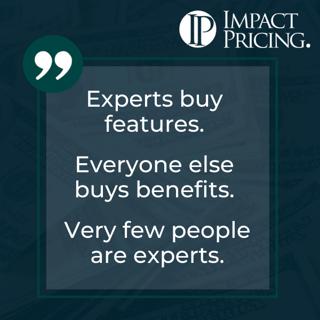
Memecast #55: Experts Buy Features
It really is fascinating that experts can translate our features into our benefits. And oftentimes as salespeople, as pricing people, as product managers or product marketers, we are experts in our own products. We think about a feature and we can automatically understand what those benefits are that our customers are going to achieve. But do our customers understand those benefits? And if they're experts then sure they do, but aren't we all trying to win new business? Aren't we all trying to find customers who are just getting into the product category, who are choosing between our products and our competitor's products? In these cases, our customers might know what the features are but they don't truly understand the benefits they should expect to receive. Imagine you've never, ever used a computer before and some salesperson tells you, yeah, this one has a terabyte static DRAM. You're thinking, okay, who cares? They have to be able to translate it into benefits. And so often when we speak to our potential buyers, we're speaking to them in the things that we think are so meaningful, our features, but they can't translate that into their benefits. If we truly want them to get the value of our products, we have to do the translation. We hope you enjoyed this memecast. This impactful insight came from my book, Selling Value, which was written to help salespeople win more deals at higher prices. If you have any questions or feedback, please email me mark@impactpricing.com. Now go make an impact. Connect with Mark Stiving: Email: mark@impactpricing.com LinkedIn: https://www.linkedin.com/in/stiving/
27 Huhti 20222min
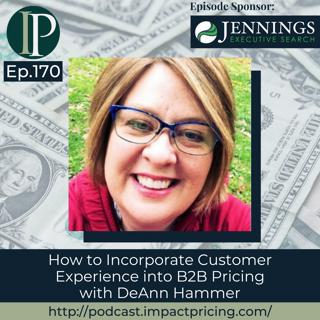
How to Incorporate Customer Experience into B2B Pricing with DeAnn Hammer
DeAnn Hammer is the Global Pricing Operations Manager at 3M, an industrial machinery manufacturing company that innovates with purpose and uses science every day to create real impact in every life around the world. She was originally a Marketing Manager in 3M. DeAnn was the valedictorian of her high school senior graduating class In this episode, DeAnn shares how she does the work of simplifying prices in a way that your customer understands as she puts emphasis on having not to negotiate once it’s properly done. Why you have to check out today’s podcast: Find out why it’s a game-changer move for you to make buying a B2C experience for clients in a world of B2B; Discover how simplifying pricing removes the need for negotiating prices in the market; and Understand how price simplification unwinds the complexity in pricing “If you make customers wait, you're going to lose the sale. Process and simplicity are going to allow you to grow your business even on really mature products.” – DeAnn Hammer Topics Covered: 01:53 – How DeAnn got into pricing; DeAnn as a market development manager 03:07 – Marketers overpricing and underpricing their products 06:34 – The difference between the roles of a pricing manager and a pricing operations manager 08:09 – Activating pricing and making it a B2C experience in a B2B world 12:36 – Houses and cars as the only things consumers negotiate for 15:15 – Unwinding the complexity in pricing through price simplification 21:00 – Determining what’s wrong with Mark’s strategy 23:34 – Having to make tradeoffs by trying to get rid of negotiated deals 25:32 – DeAnn’s piece of pricing advice for today’s listeners Key Takeaways: “You do a lot of insights work in marketing and you're gathering that information about customers’ willingness to pay, but there's also really bad questioning and marketing insights. What people tell you during insights isn't always what they mean, so you really need to pay attention to that willingness to pay and the value the product gives.” – DeAnn Hammer “Activating pricing and making it a B2C experience in a B2B world; I actually think that's how we can grow.” – DeAnn Hammer “I really think businesses have to start thinking about things that are easy, things that people understand, things that they have the data for, how can they just buy those, versus those things that are really perceived as having a much higher value in the idea that it should be negotiated. I think there's a line there about what should be negotiated and what shouldn't be.” – DeAnn Hammer “There was a time where you had to walk into a bank. There was a time you had to wait for an answer. And that's no longer the culture that we live in; we want that instant gratification.” – DeAnn Hammer “Keep it simple. Get the price out there. Let them buy it.” – DeAnn Hammer People / Resources Mentioned: 3M: https://www.3m.com/ Kelley Blue Book: https://www.kbb.com/ Carvana: https://www.carvana.com/ Connect with DeAnn Hammer: Email: dmhammer@mmm.com LinkedIn: https://www.linkedin.com/in/deann-hammer-4360a2a/ Connect with Mark Stiving: LinkedIn: https://www.linkedin.com/in/stiving/ Email: mark@impactpricing.com
25 Huhti 202228min

Blogcast #51: Pricing People Shouldn’t Set Prices
This is an Impact Pricing Blog published on March 16, 2022, turned into an audio podcast so you can listen on the go. Read Full Article Here: https://impactpricing.com/blog/pricing-people-shouldnt-set-prices/ If you have any feedback, definitely send it. You can reach us at mark@impactpricing.com. Now, go make an impact. Connect with Mark Stiving: Email: mark@impactpricing.com LinkedIn: https://www.linkedin.com/in/stiving/
22 Huhti 20223min
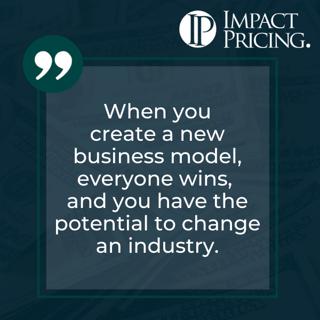
Memecast #54: New Business Models
Usually, when we think about creating a new business model, it revolves around pricing. It often revolves around, what are we going to charge for? If you think about what Netflix did when they first launched, you may recall Blockbuster was renting movies by the night, they were charging late fees. Most of their profit came from their late fees. Netflix on the other hand decided to offer a subscription where you could have one, two, or three DVDs at your house at any point in time, and you just paid a flat monthly fee. There were no late fees. What they did was changed the business model. They changed the pricing model. Now, how does this help everyone? Well, it helps everyone in the sense that now there's a group of people who prefer the subscription to the daily rental and they can go subscribe. We didn't eliminate one, although eventually, we did, but we didn't eliminate one, we just said let's offer more options to the marketplace. But in this case, especially the Netflix versus Blockbuster case, it was such a powerful thing that it really did eliminate the daily rental business. So they changed an entire industry. Take a moment. Step back. Think about how your customers really get value from your products, what they truly value, and can you change your business model to make your customers happier about the way they pay for your products? You might change your own industry. We hope you enjoyed this memecast. If you have any questions or feedback, please email me mark@impactpricing.com. Now, go make an impact. Connect with Mark Stiving: Email: mark@impactpricing.com LinkedIn: https://www.linkedin.com/in/stiving/
20 Huhti 20222min
